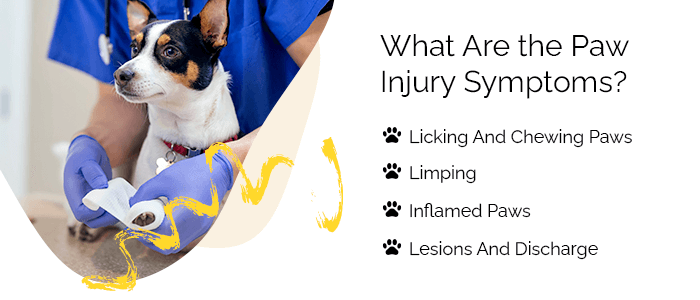
A dog's paws are some of its most important tools. They're crucial for movement, allowing it to walk, run, jump and balance. They also provide traction when walking on slippery or unsafe surfaces like ice, rocks and uneven or muddy terrain. Footpads shed water quickly, too, allowing a dog to grip most surfaces well.
Paws also help your dog stay comfortable by cooling it down when it is hot outside. The pads on the bottom of the paws are one of the few places where dogs have sweat glands. Sweat evaporates off of the pads to keep them cool.
Because dogs' paws are so important, they require plenty of attention and care. You should monitor your dog's paws and prevent situations that could damage them. For instance, dogs should not go for walks on hot asphalt or concrete. Conversely, cold temperatures and humidity cause tissue softening, cracks and wounds that can lead to infection.
As a dog owner, it is crucial for you to recognize and treat an injured paw. In this article, we will list some symptoms and types of paw pad injury so you can get your pup out of its misery.
Why Is It Important to Take Care of Dog Paws?
There are several reasons to take good care of dogs' paws:
- Paws provide stability, which allows your dog to stand firmly and comfortably on the ground.
- They serve as sensory organs, providing terrain and temperature awareness.
- Poor paw care can lead to infections or other problems that make your dog sick or at the very least uncomfortable.
- Good paw care preserves a dog's quality of life and its desire to stay active.
What Are the Paw Injury Symptoms?
Paw injuries are painful for dogs, so they respond accordingly. Certain behaviors indicate that your dog is in distress. When it seems like your dog's feet are bothering it, you should examine them to spot some common symptoms of paw injuries. While some of these symptoms could be signs of a broken paw in a dog, they could indicate other injuries.

Licking And Chewing Paws
Your pup may lick and chew its paws after an injury. If you notice your dog licking its paws incessantly, inspect them for redness, inflammation or irritation. These could be signs that a foreign object is stuck in the paw. The licking and chewing could be an effort to ease the pain or get the object out from its paws.
Limping
Limping is when your dog walks delicately, holding a paw off the ground to put less weight on a leg and prevent pain. If your dog is limping, you should check if there's anything stuck in its paw or if there is an obvious laceration on the pad that would cause pain while walking.
Inflamed Paws
If your dog’s paws are swollen or have become red, it may be due to an injured paw pad. You can check for inflammation with a visual examination, but also by feeling the paw's temperature. Red and inflamed paws are often warm or hot to the touch compared with the other paws.
Lesions And Discharge
Lesions and discharge commonly appear in a pus-like form and often have a terrible smell. Ulcers with scabbing and blisters may appear as wounds that are sensitive to touch and tender when pushed on. Moreover, cuts, abrasions, and tears usually have bleeding or oozing from them when they first occur. If you notice any of these symptoms in your dog, it is best to take it to the veterinarian for evaluation.
Most Common Dog Paw Pad Injuries to Look out For
The paw pads of our canines contain blood vessels and nerve endings, making them extremely sensitive to injury. So, it's essential to know what you should be looking out for to tend to your dog quickly if they sustain an injury. Here are some of the most common paw and paw pad injuries in dogs:
1. Cuts
Cuts are often the most common paw pad problem, especially in dogs that live in high-traffic areas or spend a lot of time playing outside. A cut on a dog's paw pad can be deep enough to expose sensitive tissues, cartilage and blood vessels. Symptoms of cuts include excess licking, whining and limping. There may also be bleeding from the injury site.
Most cuts on the feet are caused by the dog running into or stepping on something sharp. You should try to find out what he ran into so that you can remove the hazard before it happens again. Stepping on something sharp is usually accidental and may not be avoidable in the future. Deep cuts need specialized treatment to thoroughly cleanse them and help avoid infection. We recommend storing a dog first-aid kit at home for emergencies, but always see a vet after a serious cut.
2. Infections
If the skin around a cut or other paw pad injury becomes red, swollen and tender, it may be a tissue infection. Infection can occur if the wound has been left untreated for too long or doesn't heal properly. Bacteria can sometimes get into the wound and cause infection, which can spread to the rest of the foot if it's not treated.
3. Burns
Any heat source that's hot enough to burn human skin will also hurt a dog's sensitive paw pads. If something is too hot for you to touch, it's too hot for your dog. The same goes for floors. However, dogs don't sense high temperatures as acutely as we do and can sustain burns on their feet without knowing it. So, you should make sure to avoid taking your dog out on scorching days. The hot ground can cause burns on your dog’s tiny paws.
4. Cracked Paws
Dogs crack their paws for a variety of reasons:
- Walking on rough or hot terrain
- Standing in saltwater
- Living in icy conditions
- Aging process
The cracks alone don't usually develop into full-blown paw pad injuries. However, cracked skin is very susceptible to infection, so it needs to be monitored and cared for.
5. Bruising
Paw pad bruising can result from blunt force, twisting and other physical trauma. Your dog could have taken a tumble or twisted its foot while running. Accidents happen, too. You may have accidentally stood on your pet's foot, dropped something heavy on it or bumped it with your chair while it was curled under your feet. So, if you find a slight bruise, watch out for additional injuries that may have co-occurred. It could be anything from a broken toe to an internal injury that isn't immediately visible on the outside.
6. Frostbite
If you live in a cold climate, your dog can develop frostbite on its paws, especially if they spend time outdoors without any paw protection. Be sure to check your dog's paw pads throughout winter to make sure that they're still pink and full of blood supply. Frostbite can manifest as swelling, skin paleness and discoloration or stiffness. If the skin on your dog's feet starts turning black, the tissue is dying and must be removed to prevent gangrene.
7. Puncture Wound
A puncture wound is a small hole in the dog's paw. If you notice behavior like whining and excess licking but don't see a large wound, narrow your search. A puncture is small, but there may be some blood around it. Puncture wounds may be deep enough to damage the dog's paw pad, so your dog should see a veterinarian as soon as possible for proper treatment.
Punctures usually occur because something sharp pierced through the dog's paws. So, you should check the ground nearby to make sure that your dog hasn't stepped on something sharp. If you find nothing, then your dog may have stuck its paw in something sharp while playing, such as a fence, nail or thorn. A puncture can also occur if your dog gets bitten by another animal.
8. Nail Avulsion
Nail avulsion is when more than half of a dog's toenail tears from the nail bed. In addition to bleeding, this could result in swelling. This is a painful injury that would cause your dog to limp while walking and lick the wound.
To repair nail avulsion, your veterinarian will stitch the pieces back together. However, if there isn't much tissue left to connect the nail, they may need to amputate it.
9. Ingrown Nails

An ingrown nail occurs when a nail grows too long or at an odd angle, causing it to break through the foot pad. Ingrown nails can be painful and limit your dog's mobility. You should see a vet for proper ingrown treatment.
The best remedy for an ingrown nail is preventing it from occurring in the first place. Of course, some dogs are resistant to traditional nail care. Your dog may fuss when you try using clippers. Jerking their paws around could cause you to miss your mark and catch the quick, resulting in pain and bleeding.
You can use a dog nail grinder to safely weather away the nail without catching any nerves. Nail grinders are electric filers that use a diamond head to shave away the nail gently rather than cutting through it in one aggressive motion.
10. Crush Syndrome
Crush syndrome results from muscle tissue compression that causes swelling, muscle death and other symptoms. It occurs in a dog's feet when there is too much pressure for the pad and foot muscles to withstand.
When a dog puts weight on its feet, the bones in its feet form an arch. Too much pressure on the arch causes the bones to collapse, crushing the muscular tissue that supports them.
Crush syndrome often occurs when a dog jumps off of something high onto solid ground. Its paws fail to support the sudden change in pressure. This causes the dog's bones to collapse, crushing the nearby tissue and nerves. Crush syndrome is very common among dogs who weigh more than 20 pounds. Warning signs include howling and whining, which would indicate that the wound is causing a lot of pain.
11. Pododermatitis
Pododermatitis is a condition in which the paws become extremely inflamed. The cause of this inflammation and swelling is a yeast that lives on the animal's skin naturally but flourishes due to moisture or open sores on the skin. Pododermatitis is extremely painful for the dog, and it makes it difficult for them to walk on their feet.
The infection is usually treated with antifungal medication that clears up the lesion. Some cases may require surgery if a recurrence of new lesions are present. However, owners can prevent pododermatitis by keeping their dogs' paws clean and dry.
Final Thoughts
Dog paws, just like human feet, are susceptible to various wounds, laceration and infections. Always stay on the lookout for any signs of discomfort in your dog's behavior and be sure to attend injuries as soon as you spot them to prevent any further escalation. Be sure to clean your pup's paws daily and establish a grooming routine to keep them in good condition. You can find more tips on dog paw care that will help you keep your four-legged friend happy and healthy.
Last Updated on September 20, 2023 at 8:30 AM

